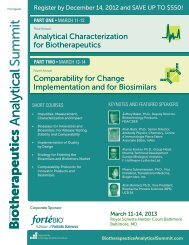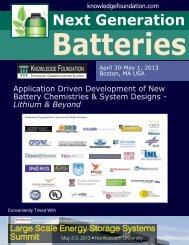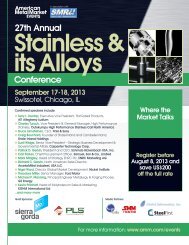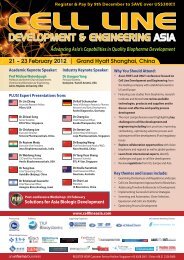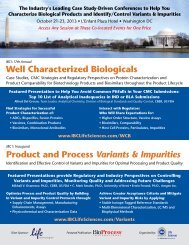Full Conference Details Inside
Full Conference Details Inside
Full Conference Details Inside
Create successful ePaper yourself
Turn your PDF publications into a flip-book with our unique Google optimized e-Paper software.
Friday, October 12, 2012<br />
7:00 Networking Coffee<br />
7:30 Technology Workshop with Light Continental Breakfast Sponsored by:<br />
New Tools for High Throughput Analysis in Biopharmaceutical Development<br />
This talk presents applications of the AssayMAP high throughput microchromatography platform for automated sample preparation prior to various protein/peptide analytical methods.<br />
The system can purify protein products from complex samples for quantitation and downstream analysis. A major application is automated sample preparation for N-glycan profiling,<br />
including enzymatic digestion, fluorescent labeling and cleanup. Peptide mapping will also be shown.<br />
Scott P. Fulton, MSc., Head, AssayMAP Operations & Workflow Development, Agilent Technologies, Inc.<br />
8:00<br />
8:15<br />
8:45<br />
9:15<br />
Cell Culture Process Development for Novel Molecules<br />
and Next Generation Protein Therapeutics<br />
Chairperson’s Opening Remarks<br />
Kathie Fritchman, Manager, BioProcess Application - Advanced Bioprocessing, BD Biosciences<br />
Expression, Purification and Characterization of an IL-1<br />
CASE STUDY<br />
Therapeutic Inhibitor<br />
UNPUBLISHED<br />
DATA<br />
Gregory Zarbis-Papastoitsis, Ph.D., Senior Director, Protein Production and Analytical<br />
Development, Eleven Biotherapeutics<br />
Kathryn Golden, M.S., Scientist III, Protein Production and Analytical Development, Eleven Biotherapeutics<br />
Process and Technology Development for the Production of<br />
UNPUBLISHED<br />
Non-Antibody Therapeutic Proteins in a Continuous Manner<br />
DATA<br />
The integration of bioprocessing steps into continuous operations is paving the future for streamlined<br />
and flexible biopharmaceutical production. Despite such simplifications, the process, hardware, and<br />
associated control strategies must be carefully optimized to achive overall robustness and product<br />
quality goals. This presentation will cover these topics as applied to the development of a continuous<br />
non-antibody protein producing process.<br />
Timothy Johnson, Ph.D., Senior Manager, Process Development, Genzyme, a Sanofi company<br />
Keynote Address<br />
The Evolution of QbD Implementation in Cell Culture at<br />
Genentech and Lessons Learned<br />
Cell Culture Recovery & Purification<br />
CASE STUDY<br />
UNPUBLISHED<br />
DATA<br />
The expectations for cell culture process characterization have evolved over the<br />
last decade, and integration of Quality by Design (QbD) principles is the latest example. Several<br />
Genentech projects have applied various aspects of QbD in the last several years, and with each new<br />
project, we’ve built upon lessons learned. The broadest QbD strategy consists of a Quality Target<br />
Product Profile, risk assessments to determine Critical Quality Attributes (CQAs), risk assessments to<br />
determine what process parameters to study, Design of Experiment studies to investigate parameter<br />
effects on CQAs, a Critical Process Parameter identification tool, risk assessments related to Control<br />
System definition, and lifecycle management. Development and use of the risk assessments and other<br />
tools has been the most challenging aspect of applying QbD to cell culture process characterization.<br />
At first glance, all the moving pieces that are part of QbD can appear quite complex, both to<br />
people within the company and to Health Authorities. While it is complex, one main benefit is that<br />
it has provided a structured approach to document rationale for how we execute and interpret our<br />
characterization studies. As we’ve become more experienced with QbD, our study designs and tools<br />
have evolved. This talk will review the evolution of tools and studies, and discuss lessons learned in<br />
applying QbD.<br />
Steven Meier, Ph.D., Principal Engineer, Senior Group Leader, Genentech, Inc.<br />
9:45 Networking Refreshment Break<br />
10:15 Thought Leadership Forum Co-Sponsored by:<br />
Understanding Sources of Process Variability<br />
Chairperson’s Opening Remarks<br />
Günter Jagschies, Ph.D., Senior Director, Strategic Customer Relations, GE Healthcare Life Sciences, Sweden<br />
Optimization of Process Steps during Scale Up to Reduce<br />
CASE STUDY<br />
UNPUBLISHED<br />
Unanticipated Sources of Process Variability<br />
DATA<br />
We had developed a three step Phase 1 mAb process using typical anion and cation<br />
exchangers (Sepharose Fast Flow). Anticipated commercial demand stimulated the development<br />
of a modified upstream process yielding a doubling in harvest titer. Fixed tankage limitations in the<br />
intended commercial facility stimulated the use of high capacity ion exchangers and a modification<br />
in the flow of the process streams which resulted in a doubling of the process throughput. The new<br />
resins were used in both the normal titer and doubled titer processes during scale-up and yielded<br />
equivalent product quality and process performance in both process versions.<br />
Joseph P. Martin Jr., Ph.D., Research Fellow,<br />
Senior Scientist, Downstream Operations, Pfizer Inc.<br />
Identification of Chromatogram Variances and<br />
CASE STUDY<br />
UNPUBLISHED<br />
Their Relation to Product Quality and Process Performance<br />
DATA<br />
Chromatogram monitoring and trending has become a routine and powerful<br />
tool to ensure consistent performance of liquid chromatography columns and quality of the final<br />
product. Trending of chromatograms against a Gold Standard was implemented for both clinical<br />
and commercial manufacturing processes at HGS to ensure downstream purification processes<br />
are performing as expected. Several case studies will be presented to demonstrate chromatogram<br />
variances and their potential impacts on product quality and process performance. Process<br />
monitoring and its follow up investigations proved to be extremely valuable for better process<br />
understanding and continuous improvement of the downstream purification processes. Several<br />
lessons learnt, in the execution of these studies, will be presented.<br />
Yaling Wu, Ph.D., Senior Scientist, Human Genome Sciences, Inc.<br />
Mitigation of Chromatography Adsorbent Lot Variability<br />
CASE STUDY<br />
UNPUBLISHED<br />
Through Design Space and Process Control<br />
DATA<br />
Lot to lot variability in chromatography adsorbent properties can result in<br />
unacceptable performance, in both product quality and process consistency. The column operating<br />
conditions may need to be designed to be adsorbent lot specific to achieve acceptable and consistent<br />
performance. In this presentation, we discuss how a design space strategy can be used to mitigate<br />
such risks for an anion exchange chromatography step, by providing additional flexibility in applying<br />
the appropriate column operating conditions for different chromatography adsorbent lots.<br />
Ionela Iliescu, M.S., Scientist I, Technical Development, Biogen Idec<br />
Structuring Process Knowledge to Achieve Robust Processes, Simplified Technology Transfer and Regulatory Compliance (See more details on p.21)<br />
19 To Register, Call: (800) 390-4078 • Fax: (941) 365-0104 • E-mail: reg@ibcusa.com • www.IBCLifeSciences.com/BPI




